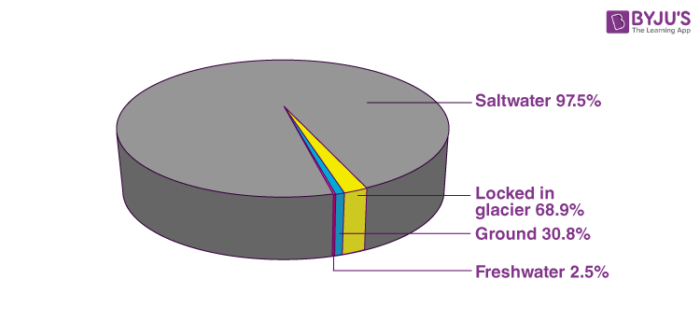Before we discuss the water cycle, let us take a look at the distribution of water on earth. Approximately 97% of the earth’s water resides in the oceans.
A fraction of the other 3% is the fresh water which is frozen up into glaciers and icebergs. The same water has been circulating around the earth for the past 4 billion years! Yes, you read that right! Possibilities are that the water that you drink today or take a shower with might have been recycled from the one that was consumed by the Tyrannosaurus of the Cretaceous period or Julius Caesar of the 100th BC. The gist is that earth’s water has been moving on, above and below its surface in an ongoing cycle called the water cycle.
What is Water Cycle?
The water cycle, also known as the hydrologic cycle, is the continuous movement of water from the earth’s surface to the atmosphere and then back to the ground. It is a continuous process. Hence, it does not have a starting or an ending point. Thus, the water present on earth has been in circulation since the evolution of the earth. Water goes through all the three states, solid-liquid-gas, in the process. There are several factors that assist the water cycle, the sun, air currents to name a few.

The stages involved in a complete water cycle are:
- Stage I: Evaporation and Transpiration The sun’s energy heats up the lakes, rivers, oceans, swamps and other water bodies which subsequently increase the temperature of the water present in them. Consequently, some water evaporates as vapour into the air. The rising air currents take the vapour up in the sky. Simultaneously, plants and trees also lose water to the atmosphere in the form of vapour which rises up in the sky.
- Stage II: Condensation As the vapours rise high, the cooler temperatures make them cool down and turn back into liquid – condensation. Wind and air currents move the moisture around, leading to the formation of clouds.
- Stage III: Precipitation Wind movements cause the clouds particles to collide. As they become water laden, they develop into rain bearing clouds and fall back onto the earth’s surface by the process known as precipitation. This may occur in the form of rain, hail, snow or sleet depending upon the temperature conditions.
- Stage IV: Runoff and Infiltration The precipitation either runs off into oceans, rivers and ground surface or is absorbed into the soil (infiltration).
Post the last stage, water is again ready to be evaporated and resume stage I. This is how the water cycle has been going on for billions of years, thus bringing fresh water to people, animals and plants, helping them survive all around the earth.








0 Comments